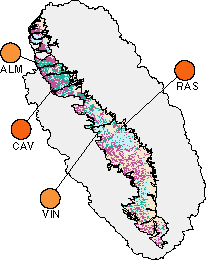|
|
Five major water-quality characteristics were evaluated for ground-water studies in each NAWQA Study Unit. Ground-water resources were divided into two categories: (1) drinking-water aquifers, and (2) shallow ground water underlying agricultural or urban areas. Summary scores were computed for each characteristic for all aquifers and shallow ground-water areas that had adequate data. Scores for each aquifer and shallow ground-water area in the San Joaquin-Tulare Basins Study Unit were compared with scores for all aquifers and shallow ground-water areas sampled in the 20 NAWQA Study Units during 1992-95. Results are summarized by percentiles; higher percentile values generally indicate poorer quality compared with other NAWQA ground-water studies. Water-quality conditions for each drinking-water aquifer also are compared with established drinking-water standards and criteria for protection of human health. (Methods used to compute rankings and evaluate standards and criteria are described by Gilliom and others, in press.) |
|
REGIONAL AQUIFER SURVEY (RAS)
All of these land-use settings represent both shallow ground water areas and drinking-water aquifers. For national comparison purposes, these land-use settings were compared with the summary scores of other drinking-water aquifers. |
Ranking of ground-water quality relative to all NAWQA ground-water studies -- Darker colored circles generally indicate poorer quality. Bold outline of circle indicates that one or more standards or criteria were exceeded.
|

|
RADONRadon concentrations were relatively high when compared with other NAWQA Study Units. No current water-quality standards exist for this element. |
|
|
NITRATENitrate concentrations in shallow ground water from domestic wells in agricultural areas were among the highest of all NAWQA Study Units. The water quality was different in areas with different crops. Drinking-water standards were exceeded in 40 percent of the wells in the almond area, and in only 15 percent of wells in the vineyard area. |
|
|
PESTICIDESPesticides were detected in more than 50 percent of ground-water samples in the Study Unit. All aquifer areas sampled had levels above the national median for NAWQA studies, but were not among the highest in the Nation. No drinking-water standards were exceeded, except for DBCP (see VOC results below). |
|
|
DISSOLVED SOLIDSConcentrations of dissolved solids in the eastern alluvial fans generally were higher than the median for all NAWQA Study Units; however, dissolved solids in areas where corn, alfalfa, and vegetables are grown were among the highest. The dissolved-solids standard is for aesthetics--appearance and smell--and though often exceeded, no health threat is indicated. |
|
|
VOLATILE ORGANIC COMPOUNDSVOCs were detected in 27 percent of the wells overall, and the per-cent detection in most of the areas was greater than the median for all NAWQA Study Units. The high rate of VOC detection and the exceedance of the drinking-water standard in 40 percent of the wells in the vineyard area are largely the result of the detection of the banned soil fumigant DBCP. |
CONCLUSIONSGround-water quality in the San Joaquin-Tulare Basins is generally poor compared with the other Study Units. Nitrate concentrations were higher than the national median and frequently exceeded drinking-water standards in all of the four areas sampled. Pesticides were fre-quently detected and the rate of detection was above the national median. No drinking-water standards were exceeded. The rate of detection for VOCs was high compared to the other Study Units because of the frequent detection of DBCP. No drinking-water standards were exceeded except for DBCP, and in one sample, EDB. |